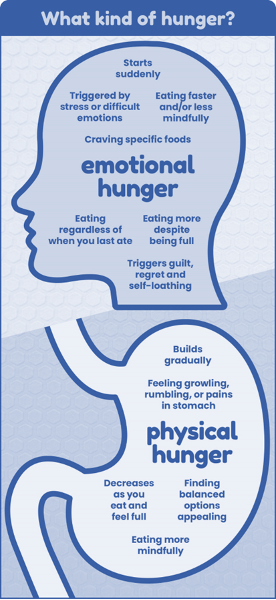Pangs of hunger strike again. Discover the difference between physical hunger and emotional hunger. It just might help you to have a healthier relationship with food.
For many of us, we’re so used to being on diets and being told when and what to eat that we’ve lost touch with our body’s hunger signals. It can take time to get back in tune with your body and its hunger and fullness signals. Start by taking a look at the difference between physical and emotional hunger.

Is emotional hunger a problem?
It’s normal to turn to food for comfort, emotional eating is a very valid coping mechanism. It might become a problem if food is your only coping mechanism.
Working out what physical hunger and fullness feels like for you
Hunger is a completely natural sensation and not something to be feared. Recognising our hunger cues can help us to know when to start and stop eating. Try using the hunger and fullness scale to begin to get a handle on your own body’s cues.
The hunger scale

Using the hunger wheel
Before you eat
Before you eat something, close your eyes and focus your attention on your stomach. Try not to let the knowledge of when you last ate influence your decision. Instead, simply let your stomach give you a number. Your body should naturally feel hunger (3 on the scale) around every 3-5 hours after you eat a meal. If you notice you want to eat or you feel hungry from somewhere other than in your stomach, it might be that you’re eating for an emotional reason or out of habit.
During a meal
Eating mindfully can help us enjoy a meal more and allow us to better tune in to our hunger and fullness signals. Pay attention to your body signals that tell you you’re no longer hungry. Aim to be comfortably full but avoid getting to the point of feeling stuffed.
Feeling full
Aim to stop eating when you’re around 6 on the hunger scale, sometimes that might mean leaving food on your plate. Most of us have been taught from a young age that it’s wasteful to leave food on our plates. Take a step back and look at the bigger picture. Yes, it may be wasteful the first few times you do this. However, gradually you’ll learn to adjust the amount of food you serve on your plate or reduce the quantities that you cook with. Remember, you can eat again later if you are hungry again and back to a 3 on the hunger scale. Aim to be within 3-6 most of the time and gradually learn to recognise the signals your body is giving you about food.
Hopefully you’re feeling a bit more confident in understanding what the different types of hunger might look like for you. Learning to listen and respond to our bodies takes time and we’re not going to get it right every time. Don’t beat yourself up if it’s taking a little longer than you wanted.


